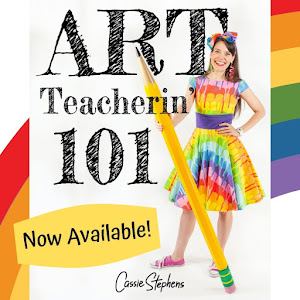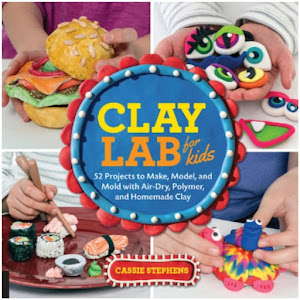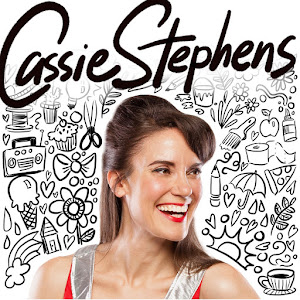 |
| The Land of the Dead: A collection of my third grade art students sarcophagi (sarcophaguses?) laid out to dry. The kids dubbed this area of the floor The Tomb. |
Last week most of my third grade students finished their Egyptian sarcophagus. We had a lot of fun with this looong project and I thought I'd share it with you. It began way back at the beginning of the school year. I remember it like it was yesterday...
 |
| Don't mess with Tut. I can't decide if I look mean or just constipated. Either one is unpleasant enough, I suppose. |
I spent the first week of school dressed as King Tutankhamun (aka Tut). As King Tut, or Mrs. Tut as the kids referred to me, I introduced all of my classes to Ancient Egypt. During this introductory lesson, my third grade students learned how to write their name in hieroglyphics and create a cartouche. If you look closely at the bottom of their sarcophagus, you'll see their rendition.
After that, we got a little side tracked with other projects: a field trip to the local art museum to see an Egyptian exhibit; a school-wide t-shirt tie-dying project; and a fall leaf-relief project. With those out of the way, we were ready to return to Egypt.
 |
| When I was in 8th grade, I had art for the first time. My art teacher showed me how to draw nostrils in a way I've never forgotten: like the handle bars of a bicycle. I demonstrated many different ways to draw a nose and this student looks like he went the handle bar route. |
We began with a self-portrait drawing. After a chat about portraiture, we looked at some recognizable portraits (the Mona Lisa and American Gothic) and compared them to the paintings found on the Egyptian sarcophagus. Then we proceeded to begin our own Egyptian self-portrait.
Each student was given a copy of the head above. The copy was on
a clipboard and the students placed a blank paper over it. After a discussion about head shape, we traced the shape of the head onto our paper. That's right, you heard me, we
traced. Scandalous, I know. We also used the dotted line as a guide in understanding the placement of our features. We used mirrors to capture our own likeness.
 |
| After looking at many Egyptian examples, students were given the opportunity to add a nemes (that's the cloth headdress), a beard (even Egyptian Queens wore them during ceremonies) and a collar necklace. |
The following art classes were used to trace over our pencil lines in Sharpie and add color with colored pencils and metallic oil pastels. We had a chat about how the Ancient Egyptians created paintings that were very two-dimensional. However, we were going to learn a bit about shading and creating a drawing that was three-dimensional.
Understanding the concept of shading is a pretty advanced skill. I introduced it to the kids anyway because I don't like assuming they cannot do something. I demonstrated by choosing a flesh tone and shading my forehead and bridge of my nose in a light value forming a letter T. I then used a dark value around the outside of the head creating a letter U. That dark value was gradually lightened as I colored toward the center of the face. The sides of the nose were shaded a dark value like two capital I's. When the students got confused about shading, I could remind them by saying, "Light T; dark U; two dark I's". This seemed to help.
 |
| A very clever student and her wadjet eyes. |
From there, details of the students' liking were added to their face and headdress. Metallic oil pastels were used on the headdress. Once complete, students were ready to cut out their sarcophagus.
For the sarcophagus, students were given a 3' (maybe a pinch longer) piece of butcher paper. They folded that paper in half lengthwise and placed half of a sarcophagus template on top which they traced and cut out. From there, the kids glued down their heads and their cartouche. Then the fun of planning their sarcophagus began.
 |
| This student paid a great interest to patterning detail. I love her designs. |
With a piece of vine charcoal, students drew hands, crook and flail and, if they wanted, Isis, the winged goddess. Then I asked them to divide break up the space of their sarcophagus with a series of lines. Once completed, students took their sarcopha-guys to the floor and painted over their charcoaled lines in black paint.
 |
| In hindsight, painting on the floor should have been done with some sort of floor cloth. I owe my custodial friends some chocolate for that mistake. |
|
In between the lines the students painted, they were asked to add patterns in black paint. Once the black paint patterns were complete, I broke out the jars of metallic paint which proved to be a big hit.
 |
| Not all metallic paint is created equally. We used Liquid Metal by Sargent sold through the Sax catalog. It was expensive but cheaper than spending money on junky (and often odorific) craft store metallics. |
Like I've said before, I only see my kids for half an hour. Some day it was a real struggle giving directions, passing back the work, getting out supplies and then turning to the clock to see YIKES! TWELVE MINUTES TO WORK! But we managed to get them finished. And, seeing them all displayed in the halls, make the kids and I see that our
looong project was well worth it.







































































